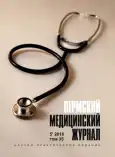New opportunities to correct equvinus foot deformity in orthopedic-traumatological practice
- Authors: Schekolova N.B.1, Zinovyev A.M.2, Kozyukov V.G.1, Tokarev A.E.1, Nenakhova Y.V.1
-
Affiliations:
- Academician Ye.A. Vagner Perm State Medical University
- Regional State Autonomous Institution “Center for Complex Rehabilitation of Invalids”
- Issue: Vol 35, No 5 (2018)
- Pages: 19-23
- Section: Articles
- URL: https://journals.rcsi.science/PMJ/article/view/10693
- DOI: https://doi.org/10.17816/pmj35519-23
- ID: 10693
Cite item
Full Text
Abstract
Aim. To prove the efficiency of using a new variant of leg tutor for correction of locomotor system pathology in treatment of equvinus foot deformity.
Materials and methods. A mean age of 23 patients with hemiparesis and equvinus foot deformity was 42.5 years. Tonus and strength of legs was assessed. Angulometric and stabilometric studies were realized.
Results. The developed model of leg tutor was used. To eliminate equvinus foot deformity, hyperextension of the knee joint was gradually eliminated using individual choice of the heel form and height, thus strengthening a quadriceps muscle of the thigh. The knee joint stability increased, the intensity of pain syndrome reduced. Arthropathies and deformities of the knee joint were prevented. Innovation of the developed model is the following: a soft glue-based responsive side of textile band “Contact” “Velcro” was stably fixed to the outside surface of posterior third of the plantar part of tutor sleeve. To the responsive side of a textile band, there were fixed removable heel pads (heels from microporous rubber of different height (from 5 to 25 mm) with a responsive hard (with hooks) part of textile band “Contact” “Velcro”). Tutor provided the ability to move and guaranteed stable holding of the extremity segments in the posterior position. There was observed a positive dynamics of changes in the muscular tonus of paralyzed leg.
Conclusions. The developed tutor model can be used in orthopedic-traumatological practice to correct equvinus foot deformity; the model efficiency is confirmed by clinical and stabilometric parameters.
Keywords
Full Text
##article.viewOnOriginalSite##About the authors
N. B. Schekolova
Academician Ye.A. Vagner Perm State Medical University
Author for correspondence.
Email: nb_sh@mail.ru
доктор медицинских наук, профессор кафедры травматологии, ортопедии и военно-полевой хирургии
Russian Federation, 26, Petropavlovskay street, Perm, 614000A. M. Zinovyev
Regional State Autonomous Institution “Center for Complex Rehabilitation of Invalids”
Email: nb_sh@mail.ru
травматолог-ортопед
Russian Federation, 39, Lodygina str., Perm, 614090V. G. Kozyukov
Academician Ye.A. Vagner Perm State Medical University
Email: nb_sh@mail.ru
доктор медицинских наук, профессор кафедры травматологии, ортопедии и военно-полевой хирургии
Russian Federation, 26, Petropavlovskay street, Perm, 614000A. E. Tokarev
Academician Ye.A. Vagner Perm State Medical University
Email: nb_sh@mail.ru
доктор медицинских наук, профессор кафедры госпитальной хирургии
Russian Federation, 26, Petropavlovskay street, Perm, 614000Ya. V. Nenakhova
Academician Ye.A. Vagner Perm State Medical University
Email: nb_sh@mail.ru
кандидат медицинских наук, доцент кафедры травматологии, ортопедии и военно-полевой хирургии
Russian Federation, 26, Petropavlovskay street, Perm, 614000References
- Гришина Л.П., Ондар В.С. Результаты переосвидетельствования инвалидов с различной патологией опорно-двигательной системы после консервативного или хирургического лечения. Медико-социальные проблемы инвалидности 2011; 2: 68-70.
- Зиновьев А.М., Щеколова Н.Б., Бронников В.А., Склянная К.А., Саитов С.А. Тутор для коррекции эквинусной установки стопы в сочетании с рекурвацией коленного сустава. Патент на полезную модель № 180010. Опубликовано 01.06. 2018. Бюл. № 16.
- Спивак Б.Г. Средства ортезирования, применяемые у больных со спастическими параличами нижних конечностей, и медицинские показания к их назначению Медико-социальные проблемы инвалидности 2013; 2: 34-40.
- Щеколова Н.Б., Зиновьев А.М. Механизмы формирования ортопедических нарушений у больных после перенесенного инсульта (обзор литературы). Уральский медицинский журнал 2016; 7 (140): 90-96.
- Щеколова Н.Б., Мудрова О.А., Ненахова Я.В., Новикова Е.А. Эффективность восстановительного лечения детей с церебральным параличом. Кремлевская медицина. Клинический вестник 2014; 3: 94-99.
- Orendurff M.S., Bernatz G.C., Schoen J.A. Kinetic mechanisms to alter walking speed. Gait & Posture 2008; 27: 603-610.
- Salzman B. Gait and balance disorders in older adults. American Family Physician 2010; 1(82): 61-68.
Supplementary files






